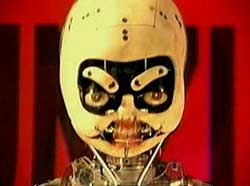ANYTHING GOES ?
There was an interesting discussion going on over at
Motl's Blogspot. It started with the analysis of a talk of Eva Silverstien
who claimed to have found even more consistent string backgrounds,
not tied any more to the usual dimension of superstrings (which is
11). If true that would mean that string theory would be even less
predictive than it appeared so far.
Motl's arguments seem strong and convincing: we just can't give up
the sacred principle of critical dimension without ruining the whole
approach. Adopting Silverstien's viewpoint would, ultimately,
translate to "anything goes" - physics without any contraints, where
everything is possible. That means, no physics at all.
I think the string physicists went too far here, the "landscape"
is already bad enough. They should adopt a more solid conceptional
underpinning for their theories. Examples for a more reasonable
direction of research is for example is
ghost condensation, which ingeniously presupposes a kinetic term with
the "wrong" sign. One may envision here a lot of generalizations,
for instance one may flip the signs of all terms in the standard
model lagrangian (incl gravity), and doing this in all possible
ways would generate a lot of new models with interesting cosmological
implications. One may also combine this scenario with various stacks
of branes, for example one may put all the known "standard model"
physics on one brane, but puts a supersymmetry breaking brane
sufficiently far away so that supersymmetry is only weakly broken.
The same can be done with CP violation in a similar way. Not to
mention to do this not in four, but in say 5 dimensions (or even
more); but that's not my point.
What I propose in this context is switching the signs of the various
kinetic terms on one brane, but keeping them as before on some other
(this is not to be taken literally, of course, for instance one may
also consider hybrid constructions where only a subset of kinetic
terms on a given brane is switched - but you get the idea). I am
pretty sure that this will lead to many new classes of interesting
models, and by picking the right branes and signs I bet one could
reproduce, earlier or later, the standard model of particle physics
as we know and love it.
That's a good example, you see? The string "physicists" should
learn from the phenomenologists to do solid and interesting physics
like this, rather than more and more loosing themselves in fancy
mathematics.


<< Home